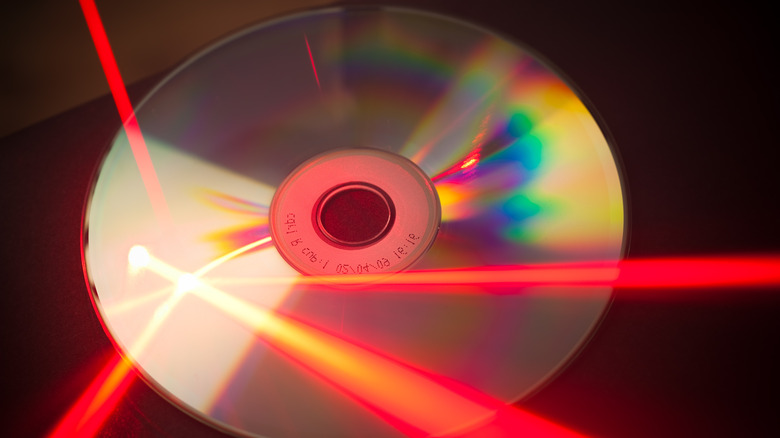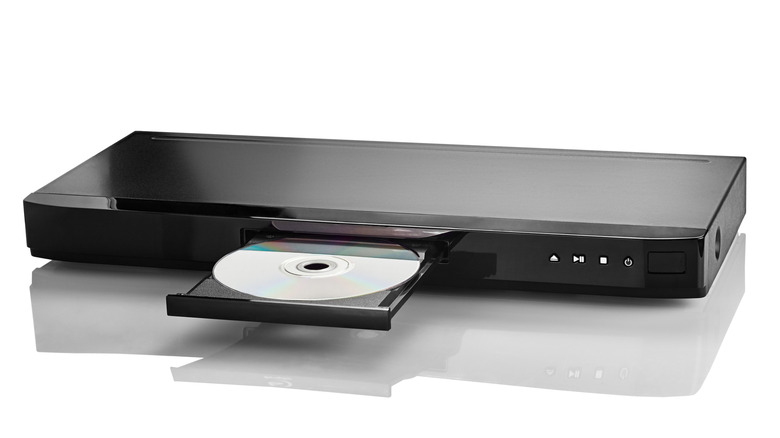What Are The Differences Between Blu-Ray And DVDs?
In October 2023, Best Buy announced the end of an era. The electronics retailer, seemingly the last national chain standing that carries a sizable selection of movies and TV shows on DVD and Blu-ray, would be phasing out physical media starting in early 2024. This would seemingly make FYE, which still has around 200 stores, the largest retailer of video discs in the United States. Even FYE, though, has long since pivoted to prioritizing toys and collectibles, and its nearly 200 stores pale in comparison to Best Buy's thousand-plus.
Having said that, physical media is still big business; it is just harder to justify from a brick-and-mortar retail perspective. According to Variety, physical media revenue in the United States was $754 million in the first half of 2023 alone, so even if it was down, it's still profitable. Despite the widespread adoption of HD and even 4K TVs, a lot of those physical media sales still consist of good old standard-definition DVDs.
That's the big difference between DVDs and Blu-rays that most video disc-buying consumers are familiar with, but there are a bunch more where those came from. Read on to learn all of the key differences between Blu-Ray and DVDs.
Blu-Rays have a different laser than DVDs
To fit much higher quality video and audio on a disc of the same physical size, even with more efficient compression, you need to change how the disc is written and read to make it hold more data. How exactly does that work, though? How have the various optical disc formats been able to stay at five inches in diameter while dramatically expanding the storage capacity with each new generation, from audio CD to DVD to Blu-ray to Ultra HD Blu-ray? The answer is that, with each new technology that allowed for more storage space on a five-inch disc, the grooves that the optical drive's laser reads are spaced closer together.
Being able to read these more closely spaced grooves requires using a laser operating at a smaller and smaller wavelength. CDs needed a 780 nm laser, while DVDs needed a 650 nm laser, which the human eye sees as red. The blue-violent laser that gives Blu-ray its name, though, is 405 nm, which applies to both versions of Blu-ray. It's these increasingly precise lasers — and multi-layer discs — that allowed optical discs to expand and hold more data, from 650MB for CDs to up to 100GB for Ultra HD Blu-rays.
Blu-Ray players stopped having analog outputs in 2013
Here's one that may surprise you. If you have an older, standard-definition TV and don't care about seeing an HD or 4K picture, you can't buy new Blu-ray players that work with those older TVs anymore. In fact, consumers haven't been able to for over a decade.
Standard-definition CRT TVs tended to last a long time and had a very limited selection of inputs, with coaxial/RF inputs (for cable connections and VCRs), composite video, and RCA stereo audio being the most common. For a long time, HD and 4K TVs had analog composite and RCA stereo inputs supplemented by HD-capable component video and VGA analog inputs, but these days, most new TVs just have HDMI. HDMI is an all-digital, all-in-one cable, and it has copy protection built in.
The market shifted, and by the end of 2013, so did the terms of the license agreement for Advanced Access Content System (AACS), the standard for digital rights management and content distribution on Blu-Ray disc players. During Blu-Ray's life, AACS had already been updated to limit all analog outputs to standard definition, but the last move was even more significant.
In a post explaining what was dubbed the "Analog Sunset," Sony explained that the new terms meant that as of 2014, no new Blu-Ray players would have any kind of analog output, just HDMI. If you're getting a video disc player for an older TV that only has analog inputs, your only choice is DVD.
DVD and Blu-Ray have different video resolutions available
The resolution of the video image — represented by the number of horizontal pixels multiplied by the number of vertical ones on each axis — on a Blu-ray disc or DVD is governed by much more than the capacity of each disc. DVD is obviously limited to standard-definition resolutions, with Blu-ray adding HD resolutions, but there's more to it than that.
Both DVD and Blu-ray have detailed specifications that outline what resolutions are "legal" on each format. The only resolutions that overlap are 720x480, the resolution that most standard retail DVD releases use, with a 4:3 or 16:9 aspect ratio, and its equivalent in countries that use the PAL color system, 720x576. For every DVD spec resolution that has 480 vertical lines of resolution in countries with the NTSC color system, the PAL version has 576 lines.
The DVD Video spec also has several other available resolutions. Working our way downward, the first is 704x480, which wasn't used much. Next is 352x480, followed by 352x240, the same resolution as Video CDs (352x288 in PAL), with both being generally used by DVD recorders, not commercial DVDs.
Blu-ray, meanwhile, adds all of the key HD and 4K resolutions, which are the same across the world: 1280x720 progressive scan (720p), 1920x1080 interlaced (1080i), 1920x1080 progressive scan (1080p). Blu-ray also has both progressive and interlaced options for 1440x1080 (for non-widescreen content) and 3820x2160 progressive (2160p) for 4K/UltraHD, though frame rates do vary between different countries.
Different video and audio codecs
Another difference between DVD and Blu-Ray is how the video and audio streams are encoded. Blu-Ray does support most of the same codecs as DVD to start with, specifically MPEG-2 for video as well as LPCM, Dolby Digital/AC-3, and DTS for audio. Blu-Ray, however, expanded the options quite a bit.
Though you can get good results with MPEG-2, more efficient codecs had arrived by the time the Blu-Ray disc spec was finalized: H.264/AVC/MPEG-4 Part 10, and VC-1, which was a modified form of Windows Media Video 9. Years later, the Ultra HD Blu-Ray standard came along using H.265/HEVC/MPEG-H Part 2, which was even more efficient at encoding video for Blu-Ray.
On the audio side, Dolby and DTS's lossless codecs — TrueHD and DTS-HD Master Audio — were added with regular Blu-Ray, while Ultra HD Blu-Ray added Dolby Atmos and DTS:X, which take advantage of height level/upward-firing speakers. Lossless compression is the opposite of lossy compression formats like MP3, AAC, AC3, and DTS. In lossy compression, the codec tries to throw out what it thinks the human ear can't hear to save more space. The technology is smart but not perfect, and sometimes, you can hear that something's been lost. Lossless compression, though, works like a zip file optimized for audio, only eliminating redundant data to reduce the file size without compromising sound quality.
Blu-Ray has online features, or at least it used to
One Blu-Ray feature that was completely unlike anything DVD had was BD-Live, which allowed internet-enabled special features on internet-connected Blu-Ray disc players. There were various ways it could be used, from downloading videos not on the disc to grabbing up-to-date actor filmographies from IMDb.
Samsung describes the content as "typically consist[ing] of behind-the-scenes videos, online games or exclusive media including music and images that you can download when your player is connected to a network." Phillips, meanwhile, said that "BD-Live features have included Internet chats, scheduled chats with the director, Internet games, downloadable features, downloadable quizzes, and downloadable movie trailers."
The feature had promise and was working with companies like Disney, but it wasn't necessarily used to its full potential and was never hyped as much as Blu-Ray's core features of superior audio and video fidelity. It's unclear if BD-Live was ever officially discontinued, but threads on the Blu-Ray.com forum suggest it's effectively dead and has been for at least a few years.





